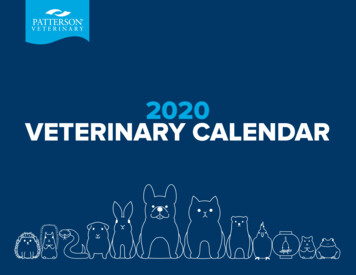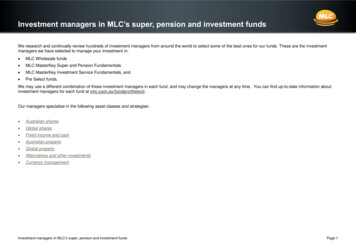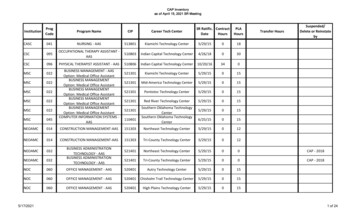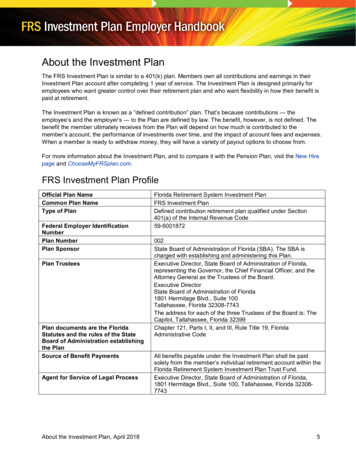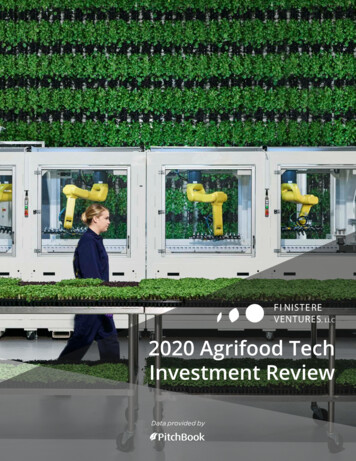
Transcription
2020 Agrifood TechInvestment ReviewData provided by
IntroductionClearly 2020 was an unprecedented year in the growth of venture investment in agrifood—as COVID-19 reshaped the world, the agrifoodinvestment community reacted quickly to the extreme uncertainty. We saw a sharp spike in Q2 capital deployment, as investors raced to supporttheir portfolios across the “COVID Gap” and in many cases, pulled forward their plans for fundraising given the inherent question about whenmarkets would reopen. In Q2 of 2020, 5.9 billion was invested into agrifood startups, more than double the historical average investment of 2.7billion for Q2 in 2018–2019, as syndicates stepped up to fund existing deals and companies raising funding pushed to close rounds.Concern regarding impacts on valuations were high during this period, but as the full year data shows, investor sentiment remained strong,valuations stabilized through Q3–Q4, and investments accelerated to produce the largest year on record in aggregate at 22.3 billion. Theresilience of investment syndicates was a key factor in this outcome. The network effect of syndicates continuing to share deal flow and engagingin new deals where trusted relationships existed, enabled strong and sustained deployment of capital despite COVID-19 constraints. The COVIDchallenge, while having massive societal impact, did not ultimately override the positive trajectory of agrifood tech investment, which continued togrow at a 50% CAGR (2010–2020). In our view, the massive total addressable market (TAM) represented by the agrifood horizontal and high growthopportunities (in food in particular), as well as the groundswell of interest in the impact of environmental, social, and corporate governance (ESG),all fueled a rising tide that shows no sign of slowing in 2021.ContentsIntroduction3Taxonomy4PitchBook methodology52020 AgrifoodTech InvestmentReviewAgtech market map6-7Credits & contactAgtech market update8-11Finistere VenturesFoodtech market map12-13INGRID FUNG Investment DirectorAR AMA KUKUTAI Co-founder & PartnerWithin foodtech, a number of sub-sectors benefited from a year where the freeze in travel, dining out, and enforced consumer saving helpeddrive a number of trends. Upticks in valuation across foodtech as well as surging investments in delivery, meal kits, and e-commerce retail werenotable effects of COVID-19 and the increase in dining at home. In turn, the exposure of supply chain pressures from animal proteins to grocerydistribution also raised investor support to tech startups in these segments, while disruptive business models such as “ghost kitchens” and “darkretail’’ also saw strong breakouts. Alternative protein has also continued a heady rise, with valuations in the stratosphere, even at early stages ofcompany development. The successes of market leaders such as Beyond Meat and Impossible Foods are being followed by the move of culturedmeat and precision fermentation technologies that are hunting for a share of the trillion-dollar-plus global protein markets.On the farm and supply side, interest in indoor ag spiked, driven by both supply chain and sustainability factors, but also by a growing consumerpreference for local and fresh produce with superior taste and quality. In early 2021, we saw the first of what will likely be a wave of special purposeacquisition company (SPAC) listings for agrifood companies. The ecosystem has expanded considerably to more than 300 startups participating inthe indoor ag “land grab”; this is expected to accelerate considerably in 2021.A renewed focus on climate change and carbon offsets appears to be gaining momentum as well. The rising ESG interest is in large part also drivenby public market trends spilling over into venture-backed companies, and is likely a key focus for investors to consider in their existing portfolios asthey contemplate both late-stage growth and exit opportunities. Indeed, with a growing cohort of late-stage companies in the sector, we will alsolikely see both more exits to private equity as well as traditional IPOs. This is a major departure from historical patterns in agrifood where exitshave been driven mainly by corporate buyouts.JENNIFER PLACE Investment DirectorFoodtech market update14-17Agrifood tech global snapshot18-19Agrifood tech at a glance20-21finistere.comA special thank you to our portfolio companieswho shared images for this report, includingPlenty Ag (cover), GoodEggs (inside-cover) andThe sector has also seen a swelling involvement by new or non-traditional players—family offices, large pension and sovereign wealth groups,late-stage PE, and continued growth in the role of CVCs across the space. In fact, 2020 saw 8,054 unique investors participate across more than9,000 transactions in the agrifood space. As we unpack the broader investment trends of 2020 in this report, there is strong indication that the racefor innovation access is heating up and creating an exciting stage for agrifood investing as we move into the next decade of investment in 2021 andbeyond.Memphis Meats (page 3).Sincerely,Afterword22ESG: Driving investment in agrifood22Appendix232FINIS T ERE V EN T URE S 2020 AGRIF OOD T ECH IN V E S T MEN T RE V IE WArama KukutaiCo-founder & PartnerFinistere Ventures3FINIS T ERE V EN T URE S 2020 AGRIF OOD T ECH IN V E S T MEN T RE V IE W
TaxonomyAgtech taxonomy PitchBook methodology Plant science: The modification of existingplants and organisms to improve planthealth and yield, including plant breeding,development of novel traits, geneticmodification/editing, and more.Crop protection & input management:The development of products andtechnologies that when applied improveplant yield, including the development ofsynthetic and natural active ingredients,biologicals, formulations, seedtreatments, and nutrient technologies toimprove plant or soil health and reduceother inputs.Precision agriculture: The building ofsoftware suites, data managementand analytics tools for improvedfarm management, including themeasurement of crop inputs, soil,moisture, weather, inventory, etc.,typically within the realm of enterprisesuites with user-friendly mobilecapabilities.Agriculture marketplace & fintech: Onlinemarketplaces for the trading, buying andselling of agricultural goods, as well asplatforms for the management of relatedfinancial transactions and administrationof business relationships.Indoor agriculture: The production ofturnkey software and hardware systemsdesigned for the cultivation of cropswithin buildings, often focused on eitherresidential or commercial real estatemarkets, as well as related services andbuilding of infrastructure.Sensors & smart farm equipment:Hardware and software systemsspecifically designed to monitor a rangeof conditions, most frequently withinclose proximity, plus equipment forfarming, with integrative capabilities forwhole platforms. Imagery: Equipment, softwareand hardware systems plus actualmanufacturing of drones and satellitesfor aerial monitoring. Animal technologies: Technologiesaimed at improving animal health andproductivity including animal genetics,feed, veterinary medicines, hardware andsoftware systems specifically designedto enable management of livestock andother farm animals in general, with usecases ranging from health monitoringto more efficient harvesting of relatedresources.Foodtech taxonomy Meal kits & delivery: Food logistics systemsdeveloped to facilitate grocery orderingand delivery, including subscriptionbased, ready-to-make meals comprisingpre-portioned ingredients. E-commerce: Marketplace developmentservices and supply-chain facing financialservices for growers to facilitate direct-toend-user distribution. Consumer health: Novel nutritionalproducts, including nutraceuticals andbeverages marketed as consumerpackaged goods. Novel ingredients: Functional ingredientsassociated with health or nutritionalclaims; industrial ingredients targetingimprovements in taste, texture, freshnessor appearance of food or providingalternatives to traditional ingredients. Processing & packaging: Discovery orcommercialization of novel processing& packaging solutions, includingtechnologies around food safety,cost-effective production or shelf-lifeextension. Supply chain: Traceability, food waste,marketplaces & procurement softwareand other technologies aimed attransforming, automating or improvingthe food supply chain. Hardware enabled: Food preparationor distribution via next-gen vendingmachines, smart ovens or roboticsused in the home or commercially forproduction. PitchBook includes equity investmentsinto startup companies from an outsidesource. Investment does not necessarilyhave to be taken from an institutionalinvestor. This can include investmentfrom individual angel investors, angelgroups, seed funds, venture capital firms,corporate venture firms and corporateinvestors. Investments received as part ofan accelerator program are not included.However, if the accelerator continues toinvest in follow-on rounds, those furtherfinancings are included. Angel & seed: PitchBook defines financingsas angel rounds if there are no PE or VCfirms involved in the company to dateand we cannot determine if any PE orVC firms are participating. In addition, ifthere is a press release that states theround is an angel round, it is classifiedas such. Finally, if a news story or pressrelease only mentions individuals makinginvestments in a financing, it is alsoclassified as angel. As for seed, when theinvestors and/or press release state thata round is a seed financing, or it is forless than 500,000 and is the first roundas reported by a government filing, it isclassified as such. If angels are the onlyinvestors, then a round is only marked asseed if it is explicitly stated. It should benoted that in order to better reflect theagtech seed-stage market, this reportincreased that round size limit to 2million or less. However, some seed-stagerounds in agtech may still not have beencaptured as of yet as a consequence.Note: This taxonomy is kept consistent from yearto year in our datasets to enable comparison overtime.Alt protein & alt dairy: Plant-based orlab-grown proteins and dairy productsmarketed directly to the consumers androoted in original IP.4FINIS T ERE V EN T URE S 2020 AGRIF OOD T ECH IN V E S T MEN T RE V IE W Early-stage: Rounds are generallyclassified as Series A or B (which wetypically aggregate together as the earlystage) either by the series of stock issuedin the financing or, if that informationis unavailable, by a series of factorsincluding: the age of the company, priorfinancing history, company status,participating investors, and more. Late-stage: Rounds are generally classifiedas Series C or D or later (which wetypically aggregate together as the latestage) either by the series of stock issuedin the financing or, if that informationis unavailable, by a series of factorsincluding: the age of the company,prior financing history, company status,participating investors, and more. Corporate venture capital: Financingsclassified as corporate venture capitalinclude rounds that saw both firmsinvesting via established CVC arms orcorporations making equity investmentsoff balance sheets or whatever other nonCVC method actually employed.5FINIS T ERE V EN T URE S 2020 AGRIF OOD T ECH IN V E S T MEN T RE V IE W
192M 183.7M 302M 109.9M 74.7M 69.2M 54.6M stageLate-stageLate-stageLate-stage 508.3MLate-stage 115M 24.8M 100.1M 474.3M e-stage 165.3MPE growth/expansion 150M 40.8MLate-stage 128MEarly-stage 1.1BLate-stageLate-stage 261.1MLate-stagePlant sciencesCropprotection& inputmanagementAnimaltechnologies 246.2M 65.7MEarly-stage 37.8MLate-stage 119MEarly-stageImageryLate-stage 59.6M 186.8MEarly-stageLate-stage 35.4MLate-stage 212.2MLate-stageAgtech market mapSelect companies, total raised& latest financings 129.8M 126.6M 541MEarly-stage 56.2MLate-stageLate-stage 335MEarly-stageLate-stage 31.5M 33.6MIndoor ag 215MEarly-stageSensors & smartfarm equipmentLate-stage 210.5MLate-stageEarly-stage 225.2MLate-stage 30MAgmarketplace& fintechLate-stagePrecision ag 24.1MEarly-stage 51.4M 531.5MLate-stageLate-stage 629.3M 74M 29.6M 78.2M 112.3M tageLate-stage 293.4M 34M 58.3M 42.6M 37M 40.6M 40M ate-stageLate-stageEarly-stageLate-stageNote: Data represents total raised.
deal counts were roughly evenly distributedacross stages, 3.8 billion—fully 76.6% ofall venture investment—went to late-stagecompanies, the highest sum on record for themost mature companies and a staggering 2.1billion increase YoY.Agtech market updateAs a result of the industry’s successfuladaptation, investment into agtech continuedto expand at a staggering pace through theend of 2020, with aggregate value increasingat a compound annual growth rate (CAGR) ofsome 50% over the last decade on a 31% CAGRin the number of funding rounds closed. Andthis momentum has carried into the new year,with an additional 747.9 million committedto agtech across 67 deals as of mid-March—results that will undoubtedly grow as moredata is collected deeper into 2021.Late-stage deals captured significant capitalfrom both existing follow-on capital fromexisting investors and investment fromgeneralist funds seeking to participate withinagrifood investing at a more derisked stage.The benefits of this dynamic are expected tofavor seasoned specialist investors, who havealready identified and are likely to own largerporportions of equity within agrifood startups.Likewise, the re-emergence of corporateventure capital (CVC) has been significant oflate, with CVCs participating in 107 fundingrounds in 2020 representing 3.2 billion incapital committed. By contrast, CVC activity in2019 represented just 770 million across 66deals. These dynamics have contributed to theGlobal agtech VC deal activity by year416334306253148 0.8 0.7 1.2 2.1 2.2 2.5 5.0201184 0.94278216185 0.3 0.3Agtech investment totaled 5.0 billion indisclosed value in 2020, an extraordinaryperformance in any context, much less afundraising environment upended by theCOVID-19 pandemic. That figure, generatedacross 416 completed financing rounds,is double the sum generated in 2019—the previous top year for agtech venturefunding. It also comprises almost a third ofthe 15.9 billion raised in aggregate acrosssubsectors such as indoor agriculture sincethe start of 2010. Certainly, 2020 was anextraordinary year for the agtech ecosystem,and the investment results speak to theresilience of investor appetite in the face ofan unprecedented black swan event thatdisrupted markets and upended supplychains. Remarkably, though, until Q4, the bulkof capital came at the height of pandemicinduced uncertainty in Q2 as investors andcompanies rapidly reacted to the radicalalterations in workflows and due 92020Deal value ( B)Deal countSource: PitchBook Geography: GlobalGlobal agtech VC deal activity by quarter 2.0 1.8 1.6 1.4 1.2 1.0 0.8 0.6 0.4 0.2 0.012010080604020Q1 Q2 Q3 Q4 Q1 Q2 Q3 Q4 Q1 Q2 Q3 Q4 Q1 Q2 Q3 Q4 Q1 Q2 Q3 Q42016201720182019Deal value ( B)02020Deal countSource: PitchBook Geography: Globalsustained growth in pre-money valuations, themedian of which for late-stage deals reachedrecord heights at 67.6 million, an increase ofroughly 61% year-over-year (YoY) in 2020.The pandemic’s impactAt midyear 2020, we reported that our regularmeetings with fellow VC firms indicatedthat syndicates with capital to deploy weremoving quickly to extend the runway for theirportfolio companies, whether in the formof bridge financings or round extensionsintended to push drywell (or cash-positive)dates out to the end of 2021 and beyond. Thisimpetus to support existing investments wasborne out in deals that show the majority oftransactions last year were led by existinginvestors.In addition to helping startups push theirfunding needs outside the “COVID-19 zone,”this funding also enabled companies toamass additional evidence of their scalability,particularly ahead of planned Series B rounds,where growth investors can see greaterpotential for on-farm adoption. Although8FINIS T ERE V EN T URE S 2020 AGRIF OOD T ECH IN V E S T MEN T RE V IE WAs anticipated, diligence and investmentsfor follow-on rounds accelerated duringCOVID-19 while companies rushed to securecapital beyond the impact of the pandemic.Consequently, some downward pressureon valuations across stages should beexpected going forward, as the impact ofearlier, prerevenue startups accepting lowervaluations at the onset of the pandemiccontinues to affect valuations. Becausevaluations can be “sticky,” we believe it maytake a year or more for the true impact ofCOVID-19 to manifest in this metric. Weforesee late-stage financings continuing toreach record heights while new capital seeksmore derisked opportunities. In contrast, weanticipate that pre-money valuations at theseed and early stages, which showed slightdecreases in 2020, will not increase for sometime.Several factors are at play here. Firstly, thepublic market’s correlation to valuations forlate-stage VC deals is much stronger thanat earlier stages as public equity marketsrallied rather quickly after hitting bottom inMarch. Record levels of dry powder combinedwith historically low interest rates fuelingstrong public market appetites for growth,empowered late-stage companies to commandhigher valuations throughout much of thepast year. However, by deal count late-stagecompanies have comprised around one thirdof deals within agtech since 2013. 2020 upheldthat trend at 29%. Despite relatively steadydeals-by-stage ratios, late-stage growth inmedian pre-money valuations reached 67.6million. In short, sizeable deals and valuationshave not translated into larger equity stakesfor investors backing more mature agtechcompanies.The 10 largest deals of 2020 for agtech* alsohighlight the push to support existing portfoliocompanies, with all but indoor ag startupRevol Greens’ massive Series A representinga fourth funding round or more—indeed, farmore in the case of Farmer’s Business Network,which notched its tenth round. The biggestdeals of 2020 also speak to the underlyingtrend toward outsized growth in capital for*See appendixGlobal median pre-money valuations ( M) by stage in agtech 80 67.6 70 60 50 40 30 20 12.7 10 5.0 020112012201320142015Angel & seedthe space, even as company developmentcycles remain lengthy. Another notable trendis the continued incidence of mega-roundsrepresenting financings of 100 million or morein aggregate capital, a figure all top 10 agtechdeals exceeded by comfortable margins. Thesedynamics helped to push the rounds at theSeries D stage and beyond to 1.4 billion inaggregate value across just nine financings.At the same time, the trend of increasingvaluation step-ups cooled off in 2020. Acrosslate-stage deals, median step-ups returned to1.3x for the year in a reversion to 2017 levelswhile angel & seed step-ups continued theirdescent from a high of 3x in 2018 to just 1.2x in2020. This dynamic is likely due to downwardpressure on step-ups from COVID-19, whichforced startups to seek capital at mutedvaluations to continue operating. For example,angel & seed median pre-money valuationsremained flat YoY at 5.0 million while medianearly-stage valuations fell from 15.6 millionto 12.7 million. All the same, a review of thecompanies that raised capital in 2020 revealsa growing number of companies coming tomarket with massive potential to alter existingagricultural systems or introduce entirelynovel production methods to their corner ofthe market.Sector trendsThe impact of COVID-19 has recast nearterm outlooks not only for the agrifoodtech value chain, but also further afield.The pandemic exposed longstandingvulnerabilities to supply chains essential to2016Early VC2017201820192020Late VCSource: PitchBook Geography: Globaloperations. Labor shortages both on-farmand at processing facilities diminished seededacreage or left product unable to reach endmarkets. Scenes of dairy farmers dumpinggallons of excess milk emerged early in thepandemic as consumer demand initiallyplummeted, prompting some to double-downon predictions that beef and dairy wouldcollapse over the next decade. But outlooksfor both the stability of and opportunitiesfor improving the agrifood tech value chainremain structured by the far greater impact ofclimate change on weather patterns, includingthe adverse consequences of extreme eventson yields going forward. These near- andlong-term themes informed the ventureinvestment trends recorded by subverticalsin 2020.Crop protection & inputs management,boosted by ag biotech investment, remainsthe leading area of venture investment. Theadditional 1.3 billion in aggregate valuegenerated in 2020 pushed funding in thiscorner of the market to some 5.3 billionsince the start of 2010. The strength of thesegment YoY translated into capturing roughlya quarter of all funding for 2020 on 15.1% ofcompleted deals—and investors have carriedthis enthusiasm into 2021, with another 268.2 million in deal value already secured.Meanwhile, venture funding has underscoredthe maturity of the companies in this space,with those at the late stage enjoying a massivemedian pre-money valuation of 310 millionlast year. Mega funding rounds for the likes ofIndigo Agriculture, which raised 500 million9FINIS T ERE V EN T URE S 2020 AGRIF OOD T ECH IN V E S T MEN T RE V IE W
in its eighth round at a pre-money valuationof 2.3 billion, illustrate the mountingimportance of generalist funds jockeyingfor position on the cap tables of maturesegment leaders. Their presence helped pushaggregate value for rounds of 25 million to 3.6 billion last year.With the recent increased pressure oninvestors to expand ESG efforts, exits tofinancial sponsors in the private equity spaceare expected to rise in coming years followingthe surge in growth investment activity.Likewise, ag carbon credit programs overseenby the likes of Indigo Ag and Nori, which allowfarmers to receive payment for carbon storedin soil via managed marketplaces, shouldencourage mainstream adoption amonggrowers. Both companies secured their initialcorporate clients in 2020, including no lessthan JPMorgan Chase and IBM. The recentproliferation of such marketplaces on theback of crop protection & input managementplatforms is nascent but expanding on thepromise to help farmers navigate the potentialupside to offsetting carbon footprints whileaddressing tail-risk to operations fromdisastrous weather events.Meanwhile, investors continued to placebig bets on longstanding consumer trendsinforming innovation across the agtechspace. For instance, organic produce salesin the US reached 8.5 billion in 2020, withthe categories representing the largest salesincreases comprising packaged salads at15.4%, berries (strawberries, blueberries, andraspberries) at 12.2%, and apples at 11.1%.The first two categories represent stapleindoor ag crops, and developments housedwithin the indoor ag segment will be essentialto increasing organic produce productionacross an ever-expanding range of productcategories.Promising to meet rising demand withoutrecourse to existing farmland systems, indoorag also approached 1.3 billion in fundingfor 2020—more than doubling YoY from 601 million raised in 2019. Category leaderssuch as Plenty, Infarm, and Bowery Farmingdeploy an integrated mix of often-proprietarytechnologies representing valuable underlyingintellectual property, including advancedsensors, irrigation systems, and data science,to control virtually every factor affectinggrowth, such as light, temperature, andShare of global VC deal value (%) in agtech by subsector for 2020Deal value ( B)6%25%6%Deal count (#)19%6%8% 5.0B16%Precision ag12%Plant sciencesAnimal tech14%15%15%ImageryAg marketplace & fintech4% 5%41616%9%24%for global markets such as Japan and SouthKorea, disruptions to global demand causedby the pandemic upended supply chains andimpacted herd health directly. Moreover,across protein-producing industries, includingpigs and poultry, localized outbreaks sourcedto processing facilities highlighted labor issuesthat exacerbated this disruption. Companiesdeveloping automated solutions for useon-farm or down the supply chain stood tobenefit as capital committed to animal techin 2020 exploded following another mutedannual performance in 2019.Sensors & smart farm eqCrop protection & inputs mgmtIndoor agSource: PitchBook Geography: GlobalVC funnelRound 1200Round 2Round 38 6127Round 497Round 557Round 6Round 710 91581737216123172253331918Raised a VC roundOut of business/bankruptcyAcquired/buyout/IPODid not advance/self-sustainingSource: PitchBook Geography: Globalnutrients. Indoor ag also brings supply closerto demand. Proving out the value propositionof indoor ag operations helped yield one ofthe top exits not only in this category but in allagtech the over past year when AppHarvestraised 475 million listing on the NASDAQwith Novus Capital, a special purposeacquisition company (SPAC), in February.Although the deal opens the door to a novelexit route for others in agtech to explore, thepreponderance of companies with activeoperations that have secured at least oneround of funding remain private players.Finally, the most significant expansion ofVC funding overall emerged in 2020 fromanimal tech, a segment that has registeredsteady but not significant inflows of capitalin recent years. However, the pandemicput raising livestock under pressure andput leaders in the segment at top of mindfor investors learning initially alongside thewider public that the outbreak of COVID-19was of zoonotic origin. Just a month after theWorld Health Organization declared a globalpandemic, findings from a team of industryand academic researchers indicated anestimated loss of 13.6 billion for the US beefcattle industry from COVID-19. With muchof the industry’s processed output destined10FINIS T ERE V EN T URE S 2020 AGRIF OOD T ECH IN V E S T MEN T RE V IE WAfter animal tech VC activity approacheda modestly elevated 65 million across 20financings coming into 2020, overall deal valuelast year would post an astonishing 12.1xincrease YoY to 847.8 million on 67 fundingrounds. Ynsect and InnovaFeed generated thepreponderance of this record sum, however.Taken together, a pair of funding rounds forthese French startups comprised almost twothirds of the sum raised in the space for all of2020. For its part, Ynsect raised a 372 millionSeries C round in October 2020 led by AstanorVentures to develop the world’s largest insectfarm, while InnovaFeed secured a 165.2million early-stage round, led by Creadev andTemasek a month later. These companies,which also plan to deploy this influx of capitalto accelerate international expansion, produceinsect-based feed for use on farms or inaquaculture. However, most of the companiesin this segment have historically focused ontechnologies to monitor, analyze, and optimizeanimal health and production, includingthe development of wearables for herdmanagement and disease prevention. Forexample, Swinetech, which raised a 7 millionround led by Innova Memphis last year, hascreated an IoT-based animal health monitoringsolution that uses AI-driven computer visiontechnology.Agtech deals ( B) by subsector 6Digital technologies (imagery, precisionagriculture, and sensors & farmequipment) generated more than 1billion in value in 2020, a fifth of the totalcapital committed across 147 transactions. Invested capital across precisionagriculture technologies more thandoubled its 2019 performance at 290.7million on 48 rounds. Although longer lifecycle investments 0.8 0.4 0.3 0.3 4 3 2 1.2 0.5 1 0 1.3201520162017Crop protection & inputs mgmtPrecision agImagery201820192020Ag marketplace & FinTechIndoor agSensors & smart farm eqAnimal techPlant sciencesSource: PitchBook Geography: GlobalAgtech deals (#) by 63201520162017Crop protection & inputs mgmtPrecision agImagery20182019Ag marketplace & fintechSensors & smart farm eqAnimal tech2020Indoor agPlant sciencesSource: PitchBook Geography: Globalcontinue to characterize plant sciences,commitments to this subvertical jumpedby 61.3% YoY to 305.1 million in aggregatevalue on just six more transactions thanwere completed in 2019.Additional sector highlights for 2020 include: 0.3 5 Ag marketplace & fintech, which includesinsurance and risk assessment servicesfor agrifinance, turned in its top annualperformance in 2020 as deal valueapproached 480 million—an increase ofsome 200 million in VC over 2019 results. Even as the pandemic drew increasedinvestment YoY into each agtechsubvertical, the presiding investmentthesis across rounds represented a clearsignal from stakeholders to segmentleaders that initiatives to help growersmanage climate change going forwardwill command elevated valuations.11FINIS T ERE V EN T URE S 2020 AGRIF OOD T ECH IN V E S T MEN T RE V IE W
64.5M 70M 111.8M 1.5B 345.5M 372.5MEarly-stageLate-stageEarly-stageLate-stagePE growth/expansionLate-stage 96.9M 143.5M 361.4M 208.2M rly-stage 2.5B 600M 700MLate-stageLate-stageLate-stage 607ME-commerce 131.8MAlternativeproteinConsumerhealthEarly-stage 43.6B 136MLate-stagePE growth/expansionSupply chainLate-stage 203.8MLate-stage 237M 327.6M t mapSelect companies, total raised& latest financings 64.7M 63.2MLate-stageLate-stage 51.7M 93.5BEarly-stageLate-stage 17.4M 415MLate-stageHardwareenabled 115.8M 43BEarly-stageMeal kits &deliveryEarly-stageEarly-stageProcessing &packagingNovelingredients 8.9M 45.2MEarly-stage 13.3MLate-stageLate-stage 1.8B 1.3B 2.4B 117.5M 21.5MLate-stageLate-stage
FINISTERE VENTURES 2020 AGRIFOOD TECH INVESTMENT REVIEW 3 FINISTERE VENTURES 2020 AGRIFOOD TECH INVESTMENT REVIEW Credits & contact. Finistere Ventures. ARAMA KUKUTAI Co-founder & Partner . they contemplate both late-stage growth and exit opportunities. Indeed, with a growing cohort of late-stage companies in the sector, we will also
